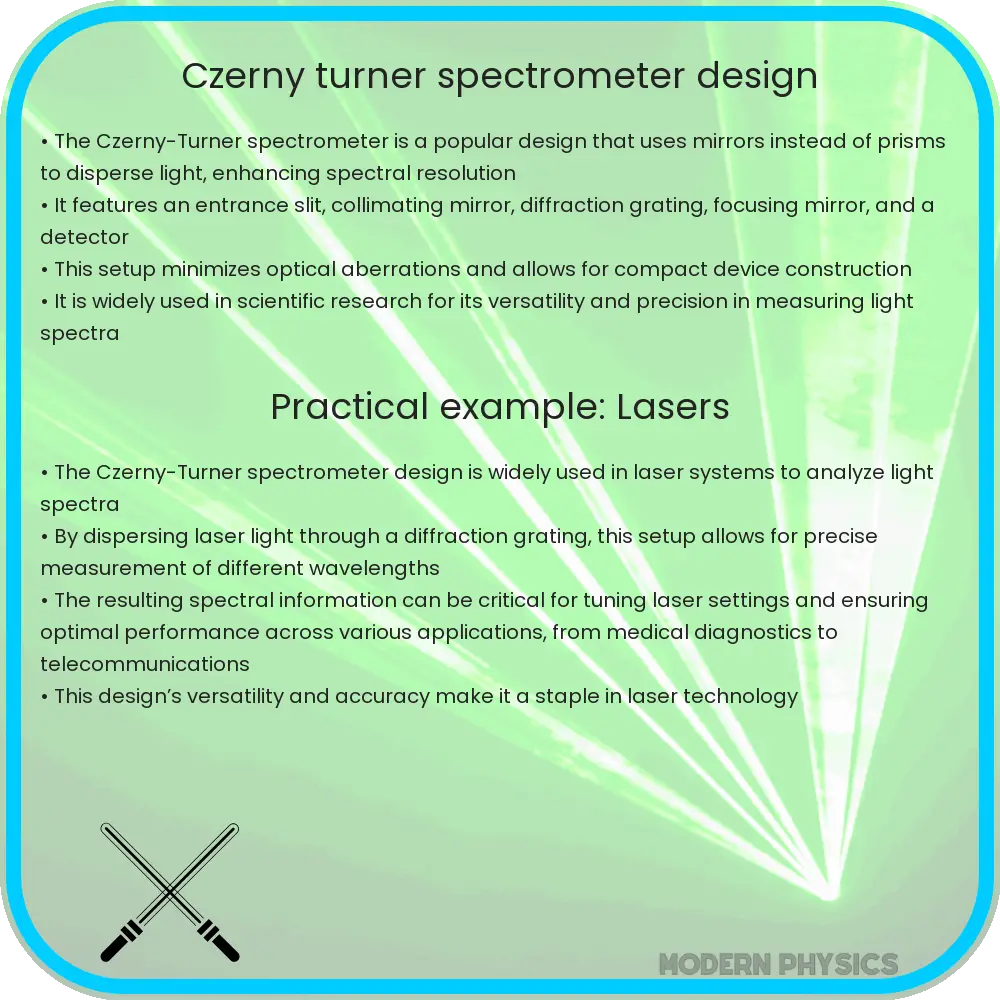Explore the Czerny-Turner spectrometer design, focusing on precision, efficiency, and alignment for high-quality spectral analysis in various fields.

Czerny-Turner Spectrometer: An Overview of Precision, Efficiency, and Alignment
The Czerny-Turner spectrometer stands out in the realm of spectroscopy for its distinctive design that marries precision, efficiency, and ease of alignment. This spectrometer configuration, named after its inventors, utilizes a simple yet effective optical layout that addresses several key challenges in spectral analysis.
Key Components and Design Principles
At its core, the Czerny-Turner spectrometer comprises two mirrors and a diffraction grating, elegantly arranged to minimize optical aberrations while maximizing spectral resolution. The primary components include an entrance slit, collimating mirror, diffraction grating, focusing mirror, and an exit slit or detector. This design leverages the diffraction grating’s ability to disperse light into its constituent wavelengths, which are then imaged onto a detector, providing a spectrum of the light source.
Advantages of Precision and Efficiency
The precision of the Czerny-Turner design lies in its ability to produce high-resolution spectra. This is achieved through careful selection and alignment of the optical components, which ensure that the dispersed light paths are optimally focused. The spectrometer’s efficiency, on the other hand, is enhanced by the use of high-quality mirrors and gratings that minimize light loss, ensuring that a maximum amount of the dispersed light reaches the detector.
Alignment for Optimal Performance
Alignment is a critical aspect of the Czerny-Turner spectrometer, affecting both its resolution and efficiency. The alignment process involves adjusting the angles of the mirrors and the grating to ensure that the optical path is optimized for the specific application. This flexibility in alignment allows for the fine-tuning of the spectrometer, accommodating various experimental requirements and light sources.
Moreover, the design’s inherent simplicity facilitates easier alignment compared to more complex spectrometer configurations. This not only reduces setup times but also enhances the reliability of the spectral data obtained, making the Czerny-Turner spectrometer a preferred choice for applications requiring high precision and efficiency.
Understanding the Czerny-Turner Spectrometer
The Czerny-Turner spectrometer is a cornerstone in the field of spectroscopy, offering a robust platform for the analysis of light spectra with high precision and efficiency. This design utilizes a simple yet effective configuration that separates different wavelengths of light, enabling detailed spectral analysis across various applications from chemical analysis to astrophysics.
Design Principles
At its core, the Czerny-Turner configuration comprises two mirrors and a diffraction grating. This setup is renowned for its flexibility in adjusting spectral resolution and range, essential for applications requiring precise wavelength discrimination. The alignment of these components is critical, as it directly influences the spectrometer’s efficiency and accuracy.
- Mirrors: The collimating and focusing mirrors are key to directing light through the spectrometer. Their alignment ensures that light of all wavelengths can be efficiently focused onto the detector.
- Diffraction Grating: This component disperses light into its constituent wavelengths. The grating’s groove density (measured in lines per mm) is a crucial factor in determining the spectrometer’s resolution.
Optimizing Performance
Maximizing the performance of a Czerny-Turner spectrometer involves careful consideration of several factors:
- Precision Alignment: The alignment of the optical components must be precise to ensure efficient light collection and accurate wavelength separation.
- Efficiency: The choice of grating and mirrors, along with their arrangement, significantly affects the spectrometer’s throughput and signal-to-noise ratio.
- Detector Compatibility: Selecting an appropriate detector for the specific spectral range of interest is crucial for capturing high-quality spectral data.
Conclusion
The Czerny-Turner spectrometer design is a testament to the balance between simplicity and performance in spectroscopic instrumentation. Its layout, emphasizing precision alignment and efficient optical component use, provides a versatile tool for scientists and engineers. By understanding and optimizing these key aspects, users can achieve high precision and efficiency in their spectral analysis tasks. As technology advances, further enhancements in component materials and digital detection methods will undoubtedly push the boundaries of what these spectrometers can achieve, solidifying their place in both research and industrial applications.
